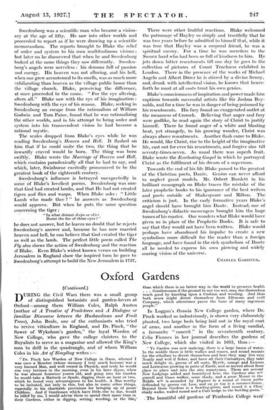Oxford Gardens
(Continued.) DURING the Civil Wars there was a small group of distinguished botanists and garden-lovers at Oxford—among them William Coles, Ralph Austen (author of A Treatise of Fruit-trees and A Dialogue or familiar Discourse between the Husbandman and Fruit Trees), John Beale, one of the enthusiasts who tried to revive 'Viticulture in England, and Dr. Pinck, " the flower of Wykeham's garden," the loyal Warden of New C011ege, who gave the college cloiSters to the Royalists to Serve as a magazine and allowed the King's men 'to drill -ift the quadrangle, and of whom William Colei 'in his Art of Simpling writes :— Dr. Pinck late Warden of New College in Oxon, whereof I was once "a Member (whose memory I Veil much honour) 'was a very learned Man, and well versed in Physiok, and truly -he would rise very betimes in the rn .moing, even in his later dayes, when he" *as almost fourscore yeares old, and going into his Garden he would take a Mattock or Spade, digging there an both- or two, which he found very advantageous to his health. A Man worthy to.:13e' imitated;- not Only in this, but also in 'many other things, especlially in- his charitable provisions for bringing up -of poore Children. And if Gentlemen_ which have little. else 41, doe, would be 'idled' by would advise them to spend their spare time in their Gardens, either in digging, setting, weeding, or the 'like;' than which there is no better way in the world to -preserve health . . . Gentlewomen if the ground be not too wet, may doe themselve,s much good by kneeling upon a Cushion and weeding. And thus both sexes might divert themselves from Idleness° and evill Company, which oftentimes prove the bane of many ingenious people."
In Loggan's. amnia New College garden, where Dr. Pinck worked so industriously, is shown very elaborately planted, two large beds being laid out in the royal coat of arms, and another in the form of a living sundial, a favourite " conceit " in the seventeenth century. Celia Fiennes in her journal describes the gardens of New .College, which she visited in 1695, thus :— .
" Ye Garden was new makeing, there is a large batten of water. In the middle there is little walkes and mazes, and round mounts for the schollars to divert themselves and here they may live very Neatly and well if Sober, and have-all their Curiosityes, they take much delight in, greens of all sorts, Myrtle, orange and Lemons and Lorrestine growing in potts of Earth, and so moved about from' place to place and into the sire sometymes. There are several Nei,/ Lodgings added and beautifyed here, the Gardens also graVell and Grass walkes, some shady, and a great Mount in the Middle aahby ascended by Degrees in a round of. Green paths deffended by greens cut Low, and on ye top is a summer-house., Beyond these Gardens is a liondilig=grocin. and round it a Close shady walke, wailed round. and a-Cuttr hedge to the-bowling green. '!
. The beautiful -old'gardens' OrPerrihroke Cbliege *cid' not destroyed till the nineteenth eentury. In Loggan they are shown with clipped galleries and they contained also a ball court, a bowling green, and a large sundial. In the pagoda, afterwards known as the Summer Common Room, Johnson used to play at draughts with John Fludyer, son of the Mayor of Abingdon who turned out " a scandal and a Whig."
The garden at Wadham, which dates from the seven- teenth century, has always been one of the glories of the College. At first Wadham had no garden, the land to the north being let, but in her will the Foundress stipu- lated that the ground which had been let was to be restored when the lease ran out, " well and sufficiently furnished with apple trees, pear trees and other fruit trees thereupon to be growing of the growth of twenty years fit for an orchard." In 1651 the larger part of the Fellows' garden was made as shown in Loggan with formal beds and the great mound in the centre with the figure of Atlas on the summit supporting " a world curiously gilded." In the late eighteenth century the old formal garden was destroyed and the grounds laid out in the new landscape fashion under the direction of Shipley, who was gardener to the Duke of Marlborough. The famous gardens of St. John's College, " a very paradise of their kind," were laid out in the same style by "Capa- bility Brown " and Repton.
Most famous of all Oxford gardens was the Physic Garden, the oldest still existing in this country. " The stately enclosure beautifully walled and gated " given to the University by Lord Danby had only been planted " with divers simples " when the Civil War broke out. It is a tradition that John Tradescant, for so long Gardener to Charles I., would have been appointed to the Physic Garden, but he died, and Jacob Hobart was made horti pratfectus at a salary of /40 " in consideration of his dressing, manureing and planting the sayed garden." He was noted for being accompanied on his walks by a goat instead of a dog. Bobart's successor was the great Robert Morison, who had formerly been physician to Gaston Duke of Orleans. Charles IL, during his exile, met Morison at Blois, and after the Restoration the King appointed him superintendent of all the Royal gardens.
ELEANOUR SINCLAIR ROHDE.































 Previous page
Previous page